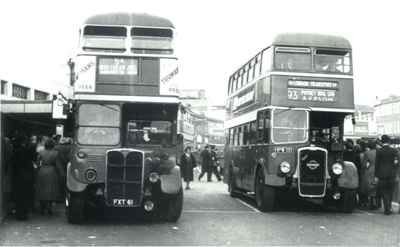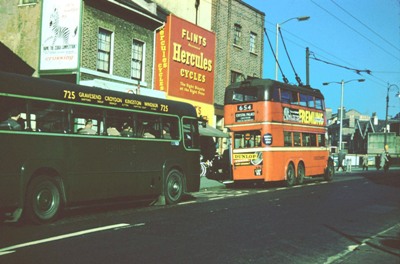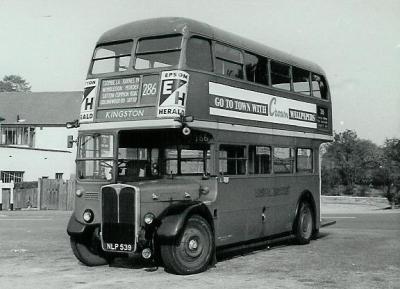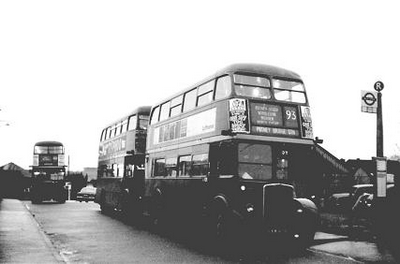Continued from Part
2
An example of the pressure on services and
vehicles after the war is green T252 working the 213, seen
here at North Cheam in reflective mode with the Queen Victoria in
the background. Alan Cross reports that just about any
single-decker in the fleet could turn up on the 213, and frequently
did. The picture was taken on Saturday 3 September 1949.
Photo © Alan
Cross
After the war the Green Line service was restored in May 1946,
with new 712/713 routes running half hourly from Dorking to
Victoria with alternate coaches to Luton and Dunstable. The buses
also increased after the war with the 213
going from 10 bph in 1942 to 14 in the peaks 1946, with 16 bph on
Saturdays, rising to 19 bph from 1949 and 16 bph MF peaks in 1952.
Despite the enormous
Saturday allocation, drawing in single deck buses from around the
fleet, it still struggled to cope with demand. One could wait for
up to 30 minutes while bus after bus passed by full up.
 These Saturday loans were not the only odd buses during
this period, with hired coaches, loaned Bristols and three Daimlers
from Maidstone appearing in North Cheam in the late 1940s.
These Saturday loans were not the only odd buses during
this period, with hired coaches, loaned Bristols and three Daimlers
from Maidstone appearing in North Cheam in the late 1940s.
A busy scene at Morden on Thursday 20 Apr 50,
with both SRT24 and Bristol HPW131 boarding for North Cheam.
The SRT is running from Clapham Common on the 5A and is
based at Camberwell, who moved them off the more arduous
route 35 after the brake modifications required by the class in
1949. Its chassis was from STL2613, and its new body
was later mounted on RT4442 in December 1953. The
Bristol, later delivered to Eastern Counties as their LKH131, was a
K5G with ECW bodywork and one of about 190 delivered new in
1949 to help cover vehicle shortages. Having arrived
from Putney Bridge, it will continue to Epsom on the 93. The
rather chaotic layout at Morden with crowds milling about
between moving buses would be inconceivable today.
Photo © Alan Cross
 The tram conversion of January 1951 saw the
5A become the 189 with no change to pattern or
frequency. Thereafter, a gradual scaling down of services through
the 50s followed the increase in fares and growing car ownership in
this reasonably prosperous part of London.
The tram conversion of January 1951 saw the
5A become the 189 with no change to pattern or
frequency. Thereafter, a gradual scaling down of services through
the 50s followed the increase in fares and growing car ownership in
this reasonably prosperous part of London.
Despite the opposition of the Central Bus Department, the big
event of 1953 was the introduction on 1 July of Green Line’s first
cross-suburban route, the 725 from Windsor to Gravesend via
Kingston, North Cheam, Sutton, Croydon and Bromley. Starting with
an hourly service, this was soon doubled in April 1954 to half
hourly.
A late-1950s photo of a well
turned-out RF on the 725 following a B1 trolleybus on the 654 in Tamworth Road, Croydon.
Photo © David Bradley
Another mid-fifties initiative was the peak hour express service
on the 93 in 1955, but this only lasted six months. The 127 was extended from South Wimbledon to St
Helier in October 1956 to replace the 32. However, the bus strike
of 1958 saw a 10 per cent reduction in services ensue with the
complete withdrawal of the 127.
 The
Sutton scheme of August 1961 saw the 156 replaced by several new
facilities including a new route 286 from Belmont to Morden via
Sutton Common Road. The 151 was also extended to become Hackbridge
– Morden – Cheam – Sutton, and then three months later on to
Belmont replacing the 213 which was cut back to Sutton. A more
fundamental change affected the 213 in May 1963 when, after the
road was lowered beneath both New Malden and Worcester Park
stations, coupled with a diversion away from Norbiton Station
bridge, the route could finally become double deck. Later changes
in the 60s saw the 213 and 213A (via Clarence Avenue,
New Malden) extended from Sutton to Morden.
The
Sutton scheme of August 1961 saw the 156 replaced by several new
facilities including a new route 286 from Belmont to Morden via
Sutton Common Road. The 151 was also extended to become Hackbridge
– Morden – Cheam – Sutton, and then three months later on to
Belmont replacing the 213 which was cut back to Sutton. A more
fundamental change affected the 213 in May 1963 when, after the
road was lowered beneath both New Malden and Worcester Park
stations, coupled with a diversion away from Norbiton Station
bridge, the route could finally become double deck. Later changes
in the 60s saw the 213 and 213A (via Clarence Avenue,
New Malden) extended from Sutton to Morden.
In the meantime, Green Line on London Road was diminishing. By
1971 only an hourly 712 remained and this was lost in May 1975. A
short-lived 703 replacement from Dorking to Baker Street survived
only until October 1976, since when London Road has been without a
Green Line service. The growth of car ownership coupled with delays
stemming from unpredictable traffic congestion had stifled
demand.
RT4374 at Belmont awaiting departure on another
tortuous journey to Kingston.
Photo © Bob Turner, Ian Armstrong collection
 The
troubled seventies opened with the 151 being converted to
one-person operation (OPO) MBs and renumbered M1 and rerouted away
from North Cheam. The Epsom end of the 93 was converted to OPO with
new route 293 from Epsom to Morden and Wimbledon. The remaining 93
was extended from North Cheam to Sutton and the 213 reverted to
it's old terminus at Belmont in place of 151.
The
troubled seventies opened with the 151 being converted to
one-person operation (OPO) MBs and renumbered M1 and rerouted away
from North Cheam. The Epsom end of the 93 was converted to OPO with
new route 293 from Epsom to Morden and Wimbledon. The remaining 93
was extended from North Cheam to Sutton and the 213 reverted to
it's old terminus at Belmont in place of 151.
At the start of the war, the
93 settled down to run between Putney Bridge Station and
Epsom. Apart from the Sunday extensions to Dorking up to
1960, the route was remarkably stable. Routemasters
first appeared as Putney garage's Saturday contribution in 1964,
one of which is seen here standing behind Sutton's RT1380 at the
Epsom Station stand in the mid-1960s. One of Leatherhead's
RTs arrives from Chessington on the 468 and will lay over further
along Station Approach. This area is much changed, with the
Odeon gone, traffic flows changed and no RTs with their warm
tungsten lighting on such a miserable Saturday morning.
Photo © Peter Osborn
Further OPO conversions in the 1970s saw the RT-operated 213
converted to DMS while the 293 was converted in 1974 to DMS
replacing the earlier Swifts. The 725 in May 1977 was bifurcated
with alternate coaches diverted at Ashford to run, as 726, via
Heathrow to Windsor. Heathrow later became the most important
traffic objective in West London. The 1970s continued their
troubled pattern, with the problems associated with OPO and
graduated fare scales, staff shortages and a succession of bus
types which did not provide the fabled reliability of more
traditional types.
Things began to improve at the end of the seventies when
Metrobuses replaced the DMS types at Norbiton on the 213 in 1979
and a rescheduling of the red bus network to match available staff
numbers transformed the performance of services almost overnight.
The 725 was cut back to Croydon in 1982 leaving the 726 alone to
the west, while the 93 was converted to OPO in 1983. This brought
Routemaster and crew operation to an end in the North Cheam
area.
Continued in Part
4